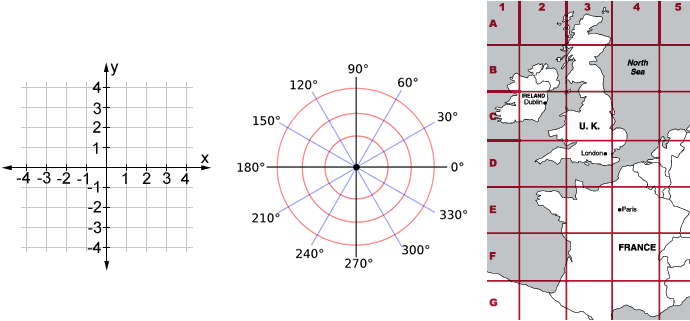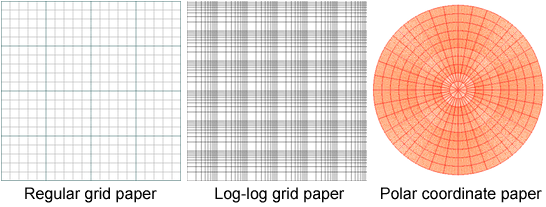Grid
In mathematics, a grid is a set of intersecting lines. It is widely used in mathematics for locating points, drawing figures, organizing data, and more.

The following are some examples of grids used in math.
Coordinate systems
Coordinate systems often use grids to help with determining the position of points in a coordinate plane. In a rectangular coordinate plane, the grid is normally parallel to the x- and y- axis. Grids are also frequently used in the context of polar coordinate systems, maps, and other coordinate systems. The following are some examples.

Graph paper
Graph paper, also called coordinate paper, squared paper, or grid paper, is paper printed with lines that make up a structure of regularly spaced, intersecting lines, that may be straight or curved. Graph paper is useful for plotting graphs and drawing curves.
Graph paper is available either as loose-leaf paper or bound in notebooks. The most common type of graph paper is printed with square grids of equal size. Log-log grid paper, polar coordinate paper, and many other types also exist.

Other usages of grids in mathematics
Grids are also widely used in mathematics for organizing data or demonstrating a concept. The multiplication table and addition table below are two examples.
| × | 1 | 2 | 3 | 4 | 5 | 6 | 7 | 8 | 9 |
| 1 | 1 | 2 | 3 | 4 | 5 | 6 | 7 | 8 | 9 |
| 2 | 2 | 4 | 6 | 8 | 10 | 12 | 14 | 16 | 18 |
| 3 | 3 | 6 | 9 | 12 | 15 | 18 | 21 | 24 | 27 |
| 4 | 4 | 8 | 12 | 16 | 20 | 24 | 28 | 32 | 36 |
| 5 | 5 | 10 | 15 | 20 | 25 | 30 | 35 | 40 | 45 |
| 6 | 6 | 12 | 18 | 24 | 30 | 36 | 42 | 48 | 54 |
| 7 | 7 | 14 | 21 | 28 | 35 | 42 | 49 | 56 | 63 |
| 8 | 8 | 16 | 24 | 32 | 40 | 48 | 56 | 64 | 72 |
| 9 | 9 | 18 | 27 | 36 | 45 | 54 | 63 | 72 | 81 |
| + | 1 | 2 | 3 | 4 | 5 | 6 | 7 | 8 | 9 |
| 1 | 2 | 3 | 4 | 5 | 6 | 7 | 8 | 9 | 10 |
| 2 | 3 | 4 | 5 | 6 | 7 | 8 | 9 | 10 | 11 |
| 3 | 4 | 5 | 6 | 7 | 8 | 9 | 10 | 11 | 12 |
| 4 | 5 | 6 | 7 | 8 | 9 | 10 | 11 | 12 | 13 |
| 5 | 6 | 7 | 8 | 9 | 10 | 11 | 12 | 13 | 14 |
| 6 | 7 | 8 | 9 | 10 | 11 | 12 | 13 | 14 | 15 |
| 7 | 8 | 9 | 10 | 11 | 12 | 13 | 14 | 15 | 16 |
| 8 | 9 | 10 | 11 | 12 | 13 | 14 | 15 | 16 | 17 |
| 9 | 10 | 11 | 12 | 13 | 14 | 15 | 16 | 17 | 18 |
